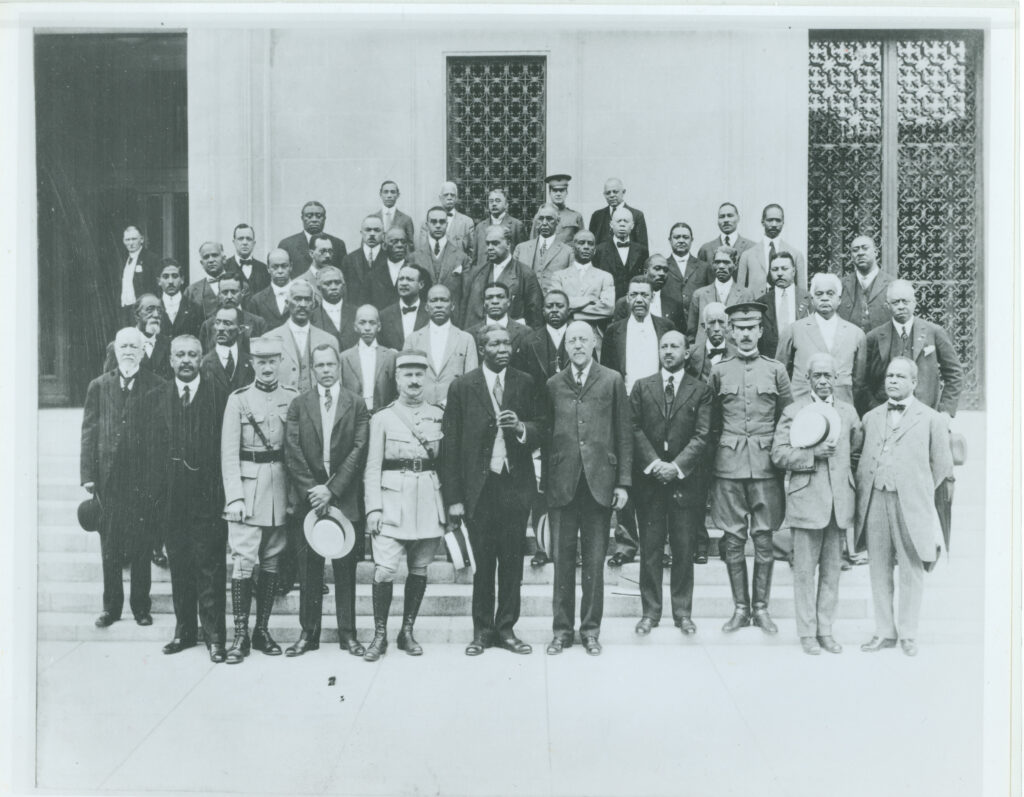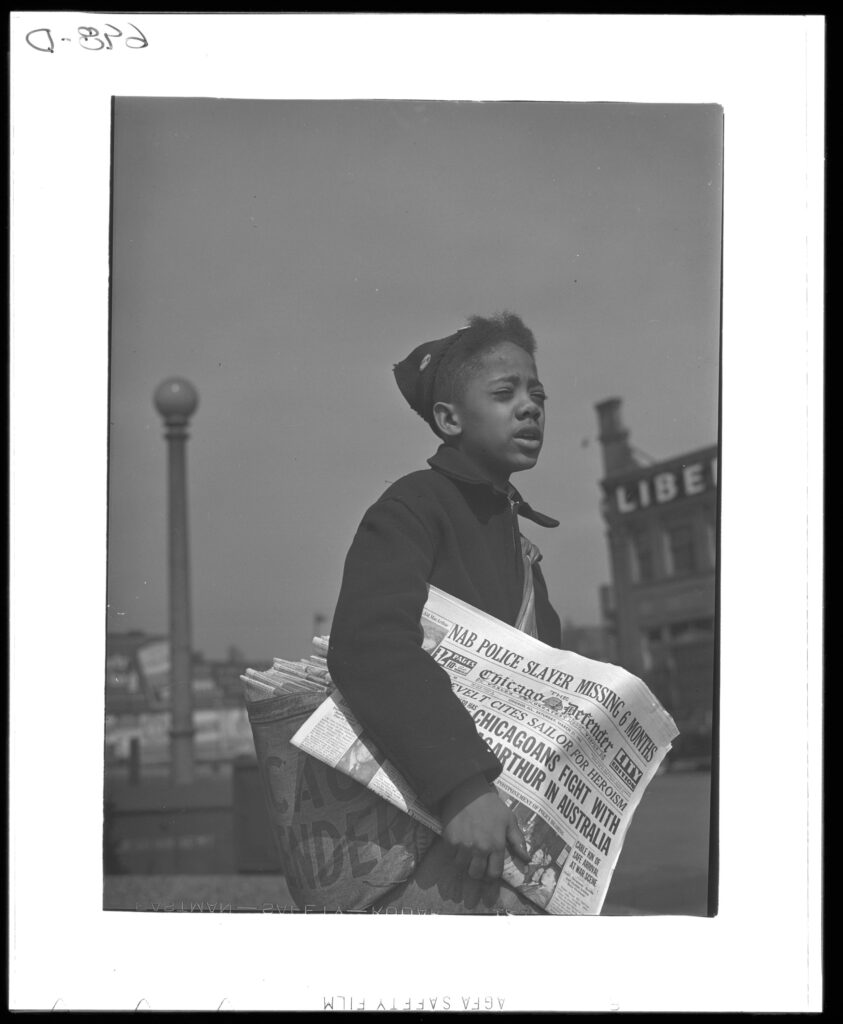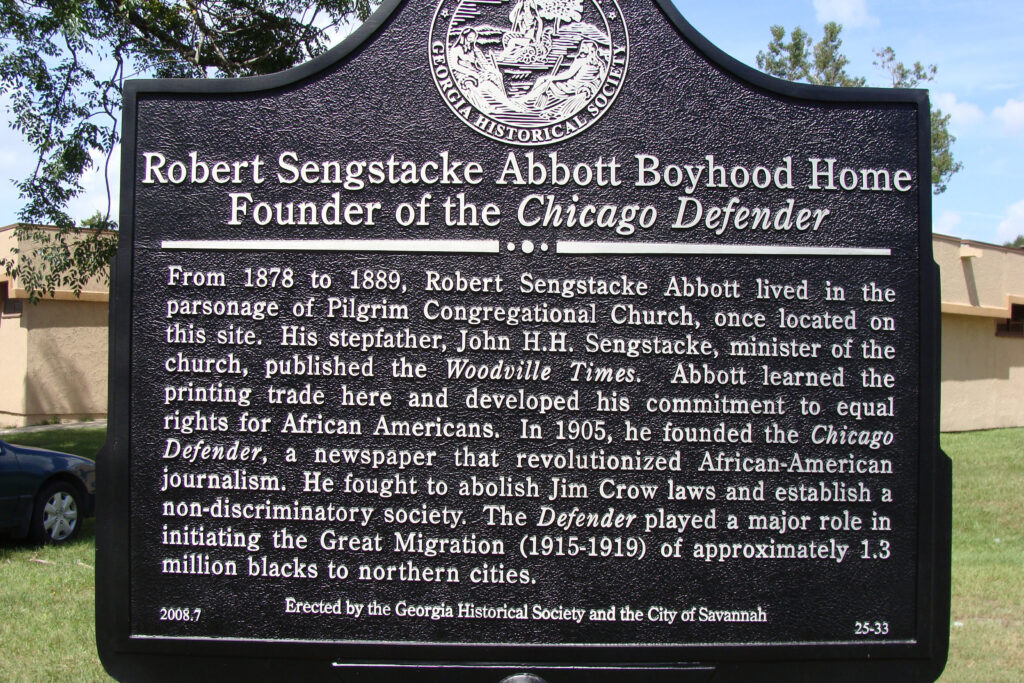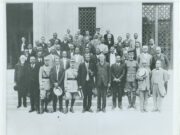Georgia native Robert Sengstacke Abbott founded, edited, and published the Chicago Defender, for decades the country’s dominant African American newspaper. Through the pages of the Defender, Abbott exercised enormous influence on the rise of the Black community in Chicago, Illinois, and on national African American culture.
Family and Education
Abbott was born on November 24, 1868, on St. Simons Island to Flora and Thomas Abbott. Abbott’s mother was born with slave status in Savannah in 1847 to Portuguese west African parents. Her father, Jacob Butler, a skilled craftsman, purchased his family’s freedom. Abbott’s father, likely of Ebo ancestry, came from a line of enslaved house workers and was majordomo of a planter’s household. He died when Abbott was an infant. Hostile to Flora for her “inferior” extraction, the Abbott clan sued for custody of the infant. John H. H. Sengstacke, a German newly arrived in Savannah, hired a lawyer who represented Flora successfully.

Sengstacke’s background held surprises. He was in fact a Savannah native; his father, Herman, was a German immigrant merchant, and his mother, Tama, was enslaved and purchased off the auction block and freed by her future husband. Married in 1847, they sent their children to be raised in Germany. Following Herman’s death, Sengstacke returned from Germany in 1869 to settle the estate in Savannah, where he met Flora and aided her custody battle. They married in 1874, and Abbott lived with them in Yamacraw and later Woodville, then a swampy, remote Savannah suburb. Sengstacke’s work as a Congregationalist minister-teacher drew criticism in this strongly Baptist area. His passion for learning and equality (and a modest foray into journalism as founder of the Woodville Times) deeply shaped the young Abbott.
After briefly attending Savannah’s Beach Institute and Claflin University in Orangeburg, South Carolina, Abbott studied printing at Hampton Institute in Hampton, Virginia, graduating in 1896. (A loyal alumnus, he later was the alumni association’s president.) He then left for Chicago, Illinois, where he earned a law degree from Kent College of Law.
The Chicago Defender
After experiencing difficulty finding employment as a lawyer because of his race, Abbott turned to journalism. In 1905 he founded the Chicago Defender, a weekly newspaper that soon dominated Chicago’s already crowded Black press. Within a decade the Defender was arguably the nation’s most important African American newspaper. Surging on the tide of Black migration north and west, circulation reached 50,000 by 1916; 125,000 by 1918; and more than 200,000 by the early 1920s—overall readership tripled those figures. Some two-thirds of this national publication’s sales were beyond Chicago.

Abbott’s newspaper included largely celebratory political, social, and entertainment reporting on Bronzeville (Black Chicago’s nickname); mostly grim racial news from the South; exhortations to newcomers for upright conduct in the face of freedom’s temptations; personal announcements from readers; employment and other classifieds; and often militant editorials for racial equality—presented with sensationalism in the style of the media giant William Randolph Hearst.
Abbott urged Blacks to fight for equality, once promoting the antilynching slogan, “If you must die, take at least one with you.” He banned the terms negro and colored as undignified; instead, the Defender consistently used the phrase the Race.
The Defender considerably influenced the Great Migration, the period when large numbers of African Americans moved from the South to urban areas in the North following World War I (1917-18). Connecting southern Blacks with one another and with northern urban communities, riding the rails with the Pullman-car porters’ massive (if informal) distribution and reporting network, and counterposing southern brutality with northern opportunity, the paper fostered and rode the epic migration. The paper even set a date, May 15, 1917, for a “Great Northern Drive.” White efforts to keep the Defender out of the South only raised its standing among Black readers.

Newsstand sales and subscriptions were the newspaper’s lifeblood. Advertising was secondary, though it grew as white-owned businesses awakened to opportunities for access to the Black public. Satisfying Black readers’ desire for aggressive racial advocacy while not alienating white advertisers proved difficult. More broadly Abbott sought a synthesis, not always easy, of racial militancy and a self-help ethos.
The newspaper’s success made Abbott an important figure locally and nationally. In the wake of racial violence in 1919, the Illinois governor named Abbott to the Chicago Commission on Race Relations, which later authored a landmark report in 1922 on African American urban conditions. Through publishing he became one of the earliest African American millionaires and a Black folk hero, embodying self-help and entrepreneurship in the mold of fellow Hamptonian Booker T. Washington.
The Defender also contributed broadly to the development of a national African American culture. One of the paper’s longtime contributors, Langston Hughes, developed the beloved character Simple in his columns.

Abbott died in Chicago on February 29, 1940, of Bright’s disease, having designated his Savannah-born nephew John H. Sengstacke his successor. The soft-spoken “country boy” who became a major shaper of African American culture would have relished Hughes’s later characterization of his newspaper as “the journalistic voice of a largely voiceless people.” He is buried at Oak Woods Cemetery in Chicago.
In August 2008 the Georgia Historical Society and the city of Savannah erected a historical marker in Savannah at the corner of West Bay and Albion streets, where Abbott’s childhood home—the parsonage for Pilgrim Congregational Church—was once located.











